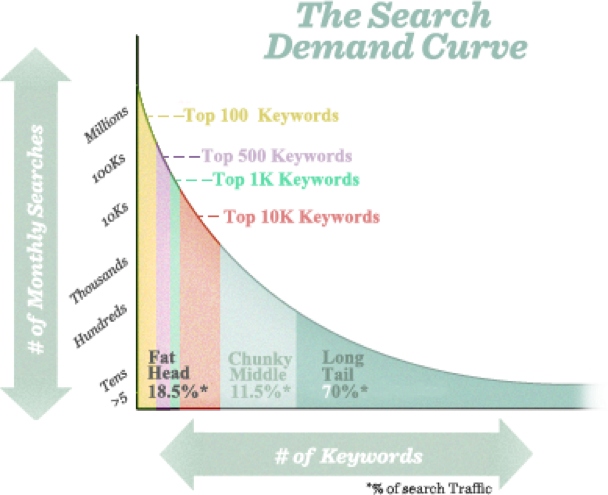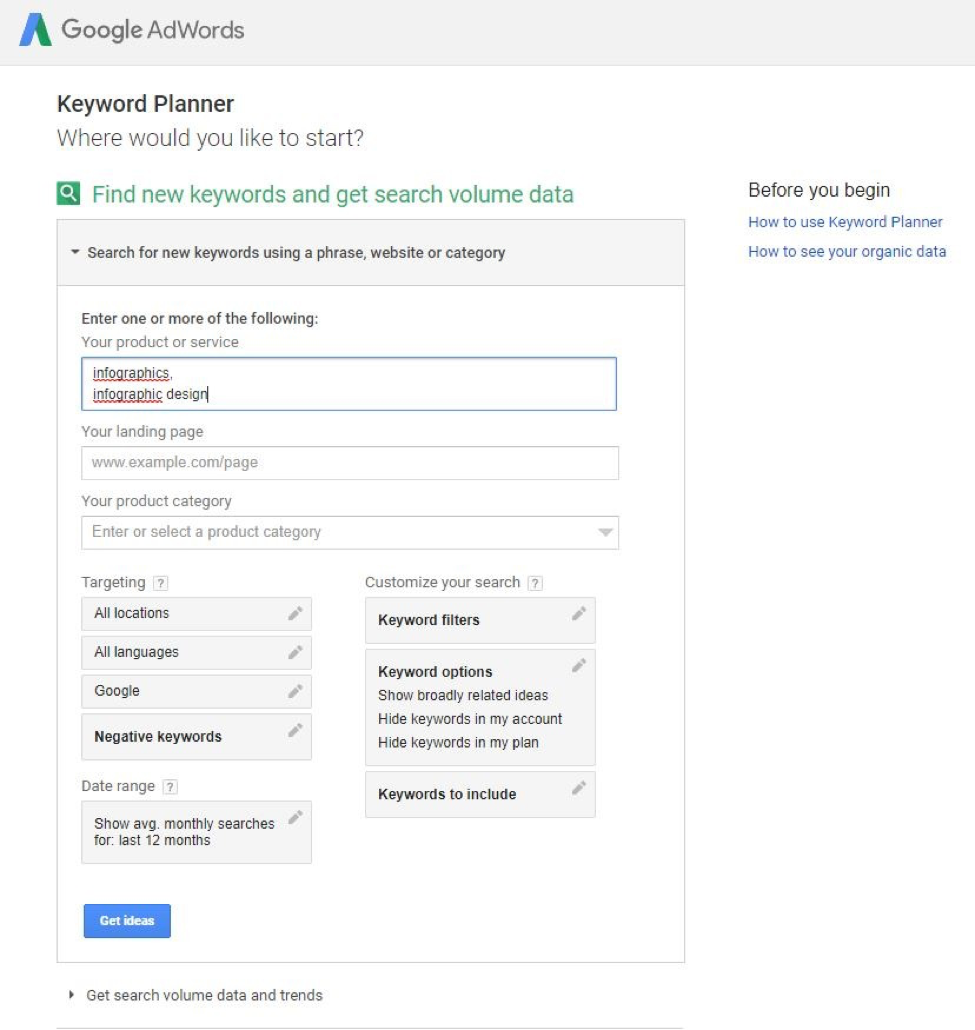- Share Ultimate Guide: Your Content Marketing Keyword Strategy on Facebook
- Share Ultimate Guide: Your Content Marketing Keyword Strategy on Twitter
- Share Ultimate Guide: Your Content Marketing Keyword Strategy on Linkedin
- Share Ultimate Guide: Your Content Marketing Keyword Strategy via email
It’s easy to get blindsided by our own opinion on “high-quality” content. You might be thinking you have an awesome idea that everyone wants to read about, but how do you know with absolute certainty that it’s really that great? And even if your hunch is spot on and you’ve discovered something truly worth sharing, how do you quantify its value? How do you find the right content marketing keywords?
To get to the bottom of these questions, it’s important to do some effective keyword research. This is because, at its core, keywords reflect the voices of your audience. Each search query is like a vote that shouts “I want more content about this!”.
So how do we do keyword research? How do we identify the search terms that people are Googling and create marketing content designed to answer these exact queries?
This process begins with understanding how people search online. In order to master the art of finding the perfect keywords to target, let’s take a look at the latest trends in Google’s search algorithms.
The Rise of Semantic Search
The Rock: Hey Siri, what’s the temperature like in Rome today?
Siri: The high temperature in Rome for today will be 80 degrees and the low will be 59 degrees.
Search is constantly evolving.
In an effort to provide more accurate search results, Google has gravitated towards what is known as semantic search. This is the ability to put searches into context in order to measure intent and meaning. Similar algorithmic innovations have led to Apple’s Siri.
The use of semantic search has completely changed the way we perform modern search queries today. A decade ago, people stuck with what was short and simple. If they wanted to find the best pizza places in New York City, they would type in “Pizza New York.” However, with Google’s Hummingbird update and the algorithmic improvements to semantic searches, people now are more inclined to type in “Where is the best pizza place in New York City.”
This trend has led to a surge in popularity for long-tail keywords.

As you can see from this Moz diagram, roughly 70 percent of search queries are now long-tail keywords.
Build Your Preliminary Keyword List
Let’s get started with all the various ways of finding keywords related to your niche so that no stone is left unturned.
- Brainstorm broad content marketing ideas
The first step is to cast your net as wide as reasonably possible. We’ll use our ideas now to come up with a far more detailed and accurate list of keywords later.
For now, brainstorm all the different content marketing ideas that relate to your business niche and write them down. My company, ResumeGo, offers resume writing services, so these would be some of the keywords that immediately pop into my head:
- Write resume
- Write cover letter
- Resume writing
- Best resume writing service
- CV writing service
- Buy resume
- Buy cover letter
- Professional resume writers
I only listed a few examples to give you some ideas, but of course your list should be longer.
- Use Google’s recommendations
You can also perform a search and see similar searches recommended by Google. You can find these recommendations at the bottom of the first search page on Google under “Searches Related to ___”.

Those are some more potential keywords to consider.
- Consider your Competitors
Often times the work has already been done for you! There are many tools that can help spy on your competitors’ keywords, such as Moz, SimilarWeb, and SpyFu.
One caveat to this approach is that the keywords you are finding are the ones that your competitors are using to SEO their company’s main sales page, as opposed to their marketing content. While there should be a lot of overlap between the two, content marketing keywords are generally more specific and long-tailed.
A different approach that remedies this problem is to copy keywords straight from your competitors’ marketing content. So how do we do this?
The first way is to check your competitors’ social media accounts. Once they have new content up, they will be sure to mention it. That’s your chance to see the content marketing they’ve been working on and decide whether or not their keywords are worth copying.
Another method is to track your competitors’ links. Content marketing is often done in unison with link building. Your competitors most likely create content on blogging sites. Within the articles they submit, there are external backlinks that point back to their own websites. Those links can be followed like a trail of breadcrumbs to track what they’ve been up to. Moz and Majestic are tools that are great for doing this. Here’s a look at what Moz found when I looked up Easel.ly, an infographics company.

From looking at just the top results, these are some keywords I’d potentially add if I were in the same industry:
- Free tools infographics
- Royalty-free images
- Free graphic design software
- Tools social media content
- Infographic creator tools
Do this same competitor analysis for each of your top competitors and you’ll be sure to have a complete list of the topics they’ve covered.
- Get customer feedback
Don’t forget, content marketing should be customer-centric. One of the best ways to know what content you should create is to find out from your customers. There are a number of ways to go about asking, whether it’s through customer surveys, social media, or just giving them a phone call. Listen to what they have to say, and jot down some unique ideas or suggestions that you might have missed yourself. Sometimes their responses can really surprise you!
Use your list to find keywords that you really want to target
Now that you have a list of potential keywords, it’s time to use keyword tools that will flesh out your content marketing ideas and allow you to create your final list of keywords.
While there are many keyword tools available on the web, it’s important to realize that every single one of these tools is really just pulling data from Google’s Keyword Planner. Only Google itself really knows the most popular search queries typed into its search engine. No outsiders have access to this information.
Instead, these other tools make inferences and estimates based off many factors and sources – one of which is Google’s own Keyword Planner. So, let’s go straight to the source of all the keywords data by using the Keyword Planner to create our ultimate keyword list!
The first thing you’ll want to do is create a Google AdWords account and start a campaign. Only after creating your campaign will Google grant you full access to their keyword planner. Here’s what I mean:

Average monthly searches you’ll see before creating your campaign.

Average monthly searches you’ll see after creating your campaign.
Creating a campaign allows you to see a more specific estimate of the average monthly search volume. Showing a range of 100,000 – 1,000,000 searches is nowhere near as helpful as knowing that there are 368,000 searches.
Once your account is set up, access Google’s Keyword Planner and enter in the keywords you gathered earlier.

Feel free to change the default settings to gear your search towards your target audience. In many cases, you’ll want to specify the location as the United States and set the language to English.

Once you hit “Get ideas,” you’ll be able to see a long list of keywords under the “Keyword ideas” section. This will give you a strong foundation for all the major short-tail keywords to add to your list.

However, what’s arguably even more important is the “Ad group ideas” tab. This is where you can really break down your broad keywords to find the exact long-tail keywords that make up the majority of searches. Simply click on each Ad group to get a more detailed keyword list.
By repeating this process with all the content marketing ideas you were able to generate from before, you’ll be able to build a comprehensive list of all the keywords that your content marketing can potentially target.
Picking the very best keywords to target
You’re almost there. You’ve got your completed list of keywords. Now it’s time to pick the ones you actually want to target with your content marketing. Be careful though, because there are a lot of different elements that go into deciding which keywords are right for you, and you should be wary of common keyword planning mistakes.
Here are some factors you should consider:
- Search Volume: This is the average number of times the keyword is searched every month.
Things to be aware of:
- Contextualize the volume numbers you see. There are exact matches, phrase matches, and broad matches. Check out Google’s support guide on these match types.
- Remember that these are per-month numbers.
- Take into account the volume trend. Is the overall trend going up or down?
- Consider negative keywords – they can sometimes make the volume numbers you actually care about look higher than they really are.
- Higher volumes usually means more competition, so it’ll usually be harder to rank for the most popular keywords.
- Google’s Keyword Planner, Moz, SEMrush, etc… all display different results partly due to the variables mentioned above, and partly due to other details of how they measure search volume
- Keyword Difficulty (KD): This is the level of difficulty of ranking for the keyword.
Things to be aware of:
- This data is not shown on Google’s Keyword Planner. Don’t mistake the “Competition” column for KD.
- Higher difficulty usually means more potential value.
- Numbers aren’t very accurate on many keyword tools, so do your own research. I recommend using Moz’s toolbar.
- Use Moz to check the Page Authorities for the results on the first page. The higher the Page Authorities, the harder it will be to rank for the keyword.
- Cost-per-click (CPC): True to its name, this shows how much advertisers are willing to pay for users to click on an advertisement shown for that particular keyword.
Things to be aware of:
- CPC stats can be very misleading when it comes to valuing your content marketing keywords because your audience won’t be coming from Google ads.
- Higher CPCs generally means that the keyword is more valuable on a per-search basis.
- If two keywords have the same volume, but different CPCs, the one that has the higher CPC is usually more valuable. However, it will most likely be harder to rank for as well.
- Content Relevance: Not all content is created equal. The content you create needs to resonate with your specific audience and generate interest in what your company is about. What do I mean?
Let’s imagine that you’re a content marketing agency. There are two keyword phrases you can target:
“how to hire a content marketing agency”
or
“how to create marketing content for free”
Although I’m sure these two keyword phrases don’t actually share the following similarities, let’s pretend for a moment that the two phrases share identical search volume, keyword difficulty, and cost-per-click numbers.
With that being true, these two keyword phrases are not equally valuable to you. The first keyword phrase is going to generate you more leads because the users searching for that phrase are going to be more inclined to hire your agency. That’s why they searched the keyword to begin with.
On the other hand, people searching for the second keyword phrase are specifically looking for free content and will most likely not be in a spending mood.
- Estimated Costs: Creating content to adequately target specific keywords will require varying amounts of time, money, and effort. In some situations, you might find that targeting a certain keyword also allows you to SEO your landing page at the same time. So be on the lookout for shortcuts that might make ranking for a keyword more cost-efficient than it would otherwise be. That’s how you can find real money-makers!
In Conclusion
Your content marketing strategy can surpass all expectations or fail epically depending on the keywords you choose to target. The key is to take your time and be thorough in your research.
Luckily, all the keyword tools and data you need are right there at your fingertips. Use them wisely and you can create a keyword-driven marketing strategy that will get your content onto the front page of search engine results and inspire your audience to take action.







